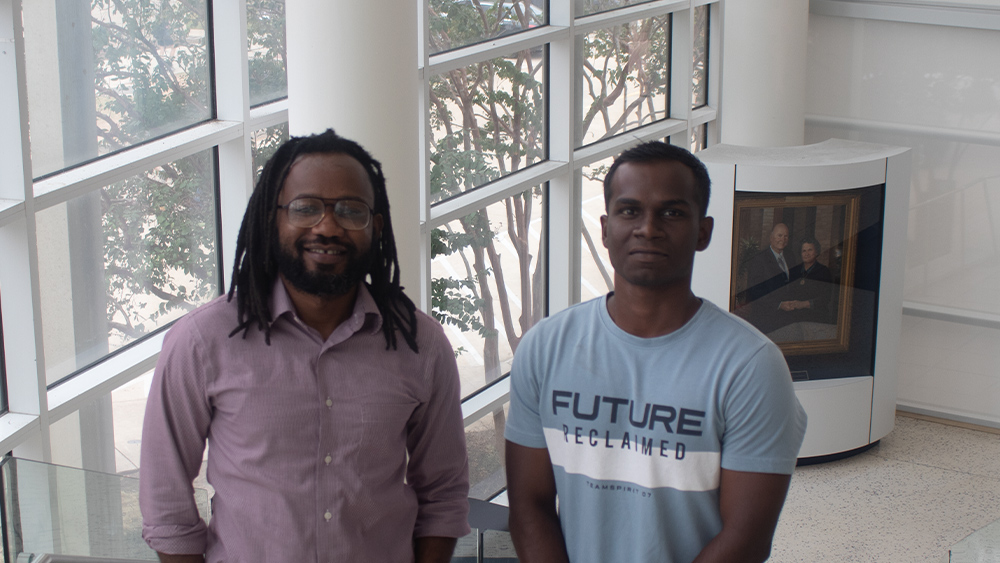
A sustainable route to green hydrogen production is becoming possible through the use of efficient electrocatalysts in research by Texas A&M University chemical engineering professor Dr. Abdoulaye Djire.
In CHEM Catalysis, Djire, chemical engineering graduate student David Kumar Yesudoss and materials science and engineering professor Dr. Miladin Radovic explain their research using MXenes — a new class of 2D-layered material — as a catalyst supporting Ru-atom for hydrogen evolution reaction (HER) catalysis for green hydrogen production.
The goal is to produce green hydrogen using cheap, earth-abundant materials that use renewable electricity. Platinum — an expensive noble metal — is the current benchmark catalyst for this reaction. Using these inexpensive catalysts instead of platinum will significantly reduce the cost of the resulting hydrogen technology, Djire said.
“My work is centered around designing and evaluating materials to be used as catalysts for sustainable chemical production,” Yesudoss said. “We have been able to reduce the cost of catalysts that are used in producing green hydrogen by half, which I think is really significant.”
More than 95% of hydrogen used in the chemical industry is produced through steam methane reforming — a fossil fuel method with negative environmental impacts, Djire said.
The existing commercial method of producing hydrogen is not sustainable and adds to global warming. Djire said this work will pave the way for sustainable hydrogen technologies.
"We showed the reaction rate of the electrochemical conversion processes could be increased by modifying the electrochemical responses of these 2D nanostructured materials (called MXenes) fabricated in our laboratory at Texas A&M University,” Djire said. “By inserting metal, we were able to tune inexpensive materials and enhance their performance to match closely that of noble metals. Specifically, into the structure of the material, we can enhance the electro-catalytic performance of the material significantly.”
Ultimately, the group aims to further lower the cost of the system by refining the particle size down to individual atoms.
“Such noble metals are hard to mine; our approach will make sure each atom is effectively utilized for green hydrogen production,” Yesudoss said. “Roughly, the size of one atom is less than a nanometer. So, we are talking about 50,000 times smaller than a human hair.”
The group used density functional theory to show synergistic effects between Ru and MXene that was performed by their collaborator Dr. Kingsley Obodo from North-West University in South Africa. This collaboration was established through the U.S.-Africa Frontiers of Science, Engineering and Medicine symposium in Nairobi, Kenya, last year, where Djire and Obodo were both invited participants.
“In this study, we opened an avenue for one more, and possibly most promising, application of MXenes as catalysts for HER,” Radovic said.
Results showed the Ru atoms attach preferably to the surfaces of the MXene. From these findings, a new approach of tuning the electrocatalytic activity of MXenes was found to accelerate the development of cost-effective, efficient and sustainable hydrogen technology.
“If further developed, this technology has the potential to revolutionize the chemical industry,” Djire said.
Additional participating collaborators include graduate student Ekenedilichukwu Uwadiunor and undergraduate student Hoang Nguyen from the Artie McFerrin Department of Chemical Engineering at Texas A&M along with graduate students Vrushali Kotastane and Eugenie Pranda from the Department of Materials Science and Engineering at Texas A&M and Dr. Kingsley Obodo from HySa Infrastructure at North-West University in South Africa.
During the U.S.-Africa Frontiers symposium last year, Djire met Obodo and noticed his work involves computational work, where they use machine learning, density and functional theory. From there, the partnership began.